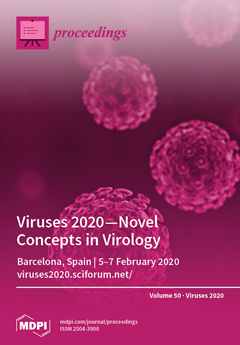Need Help?
Proceedings, 2020, Viruses 2020
Viruses 2020—Novel Concepts in Virology
Barcelona, Spain | 5–7 February 2020
Volume Editors:
Eric O. Freed, NCI-Frederick, USA
Albert Bosch, University of Barcelona, Spain
- Issues are regarded as officially published after their release is announced to the table of contents alert mailing list.
- You may sign up for e-mail alerts to receive table of contents of newly released issues.
- PDF is the official format for papers published in both, html and pdf forms. To view the papers in pdf format, click on the "PDF Full-text" link, and use the free Adobe Reader to open them.
Cover Story (view full-size image):
This volume of Proceedings aims to gather the papers presented at the Viruses 2020—Novel Concepts in Virology, held on 5–7 February 2020 in Barcelona, Spain. Viruses continue to play a
[...] Read more.
This volume of Proceedings aims to gather the papers presented at the Viruses 2020—Novel Concepts in Virology, held on 5–7 February 2020 in Barcelona, Spain. Viruses continue to play a central role in all aspects of biomedical research, ranging from molecular and cell biology, structural biology, and immunology to evolution, epidemiology, and bioinformatics. This conference brings together 240 leading virologists from around the world and across the broad field of virology to share results of their recent studies. Viruses 2020 allowed for an information exchange between experienced researchers, engineers, and young scientists who are taking their first steps toward innovation.
Previous Issue
Next Issue
Issue View Metrics
Multiple requests from the same IP address are counted as one view.



